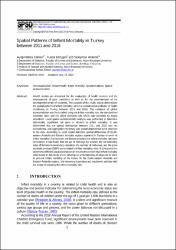| dc.contributor.author | Turkan, Ayca Hatice | |
| dc.contributor.author | Erdugan, Funda | |
| dc.contributor.author | Aldemir, Suleyman | |
| dc.date.accessioned | 2021-01-14T18:10:57Z | |
| dc.date.available | 2021-01-14T18:10:57Z | |
| dc.date.issued | 2020 | |
| dc.identifier.citation | Türkan, A. H., Erdugan, F., Aldemir, S. (2020). Spatial Patterns of Infant Mortality in Turkey between 2011 and 2016, International Review for Spatial Planning and Sustainable Development, 8(4), 1-15. | en_US |
| dc.identifier.issn | 2187-3666 | |
| dc.identifier.uri | https://doi.org/10.14246/irspsd.8.4_1 | |
| dc.identifier.uri | https://hdl.handle.net/20.500.12587/12833 | |
| dc.description | Erdugan, Funda/0000-0001-7199-6413 | en_US |
| dc.description | WOS:000584994600001 | en_US |
| dc.description.abstract | Health studies are important for the evaluation of health services and the improvement of poor conditions as well as for the determination of the development levels of countries. The purpose of this study was to demonstrate the spatial patterns of infant mortality, which is considered an indicator of health conditions, in Turkey between 2011 and 2016. The existence of global autocorrelation was first studied using the infant mortality rate, the standardised mortality ratio, and the infant mortality rate which was corrected by Bayes smoothers. Local spatial autocorrelation analysis was performed to determine statistically significant hot spots or clusters in infant mortality. It was determined that the spatial distribution between 2011 and 2016 was not coincidental, and aggregation tendency and spatial dependence were observed in the data. According to local spatial statistics, spatial differences of Southeastern Anatolia and Eastern Anatolia regions appeared in Turkey in terms of infant mortality. Furthermore, the factors related to the infant mortality rate were considered. It was found that the age of marriage for women, the net schooling rates of females in secondary education, the number of midwives, and the gross domestic product (GDP) were related to infant mortality rates. It is important to determine different associated factors in the provinces with high infant mortality rates found in this study and to develop an understanding of what can be done to prevent infant mortality in the future. In the South-eastern Anatolia and Eastern Anatolia regions, it is necessary to produce and implement policies with the scope of reducing the infant mortality rate. | en_US |
| dc.language.iso | eng | en_US |
| dc.publisher | INT COMMUNITY SPATIAL PLANNING & SUSTAINABLE DEVELOPMENT | en_US |
| dc.relation.isversionof | 10.14246/irspsd.8.4_1 | en_US |
| dc.rights | info:eu-repo/semantics/openAccess | en_US |
| dc.subject | Geovisualisation | en_US |
| dc.subject | Infant Health | en_US |
| dc.subject | Infant Mortality | en_US |
| dc.subject | Spatial Analysis | en_US |
| dc.subject | Spatial Autocorrelation | en_US |
| dc.title | Spatial Patterns of Infant Mortality in Turkey between 2011 and 2016 | en_US |
| dc.type | article | en_US |
| dc.contributor.department | KKÜ | en_US |
| dc.identifier.volume | 8 | en_US |
| dc.identifier.issue | 4 | en_US |
| dc.identifier.startpage | 1 | en_US |
| dc.identifier.endpage | 15 | en_US |
| dc.relation.journal | INTERNATIONAL REVIEW FOR SPATIAL PLANNING AND SUSTAINABLE DEVELOPMENT | en_US |
| dc.relation.publicationcategory | Makale - Uluslararası Hakemli Dergi - Kurum Öğretim Elemanı | en_US |
















